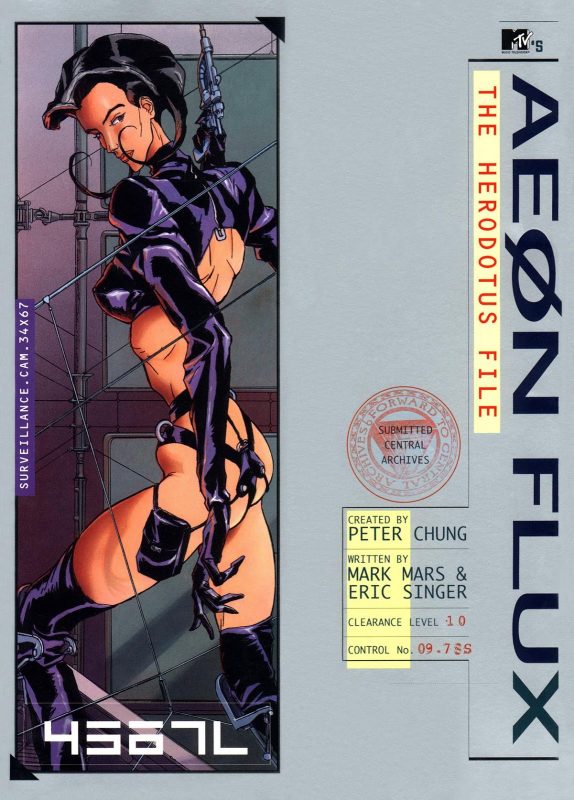
“I have been accused of caring nothing for the truth, but on the contrary, I value the truth so highly that I make sure it is hidden away someplace safe, where it is not soiled by dirty hands, embarrassed by prying eyes, or worn out through overuse.” – Chairman Trevor Goodchild
Aeon Flux is an animated exploration of psyche and politics. It’s a hard show, a cult hit where “cult” rings truer than “hit”, and it raises questions that carbon-based minds are ill-equipped to answer.
Casual viewers of the show can’t let go of the idea that Aeon Flux’s ambiguities are actually puzzles with solutions. Why are Monica and Bregna fighting? Were Aeon and Trevor ever in a relationship? We’re not supposed to know the answers to these questions, and episodes like “Utopia or Deuteranopia?” (featuring a deluded disciple who painstakingly “deciphers” his master’s encoded notes, only to learn they’re garbled madness) deride you for caring. But it’s still the typical line of analysis Aeon Flux receives: witness this grueling interview where Peter Chung is asked whether Aeon is a robot, a cyborg, or a clone. I mean, she keeps dying and coming back to life and surely there’s a rational explanation for that, right?
In 1995, MTV’s publishing arm decided to explain Aeon Flux’s universe once and for all – something like The Star Fleet Technical Manual may have been the model – and commissioned a few writers to create a book. I doubt they wanted anything like the Herodotus File, but they still put it in print. It was reissued in 2005 to tie in with the craptacular Charlize Theron movie.
It’s framed in a clever way: as a dossier from Bregna’s internal police. It’s a little like The Screwtape Letters, written by bureaucrats for bureacrats, dripping with a mixture of pathological malice and corporate bullshit.
Basically, Bregnan leader Goodchild seeks to crush a heretical Monican movement that claims that Monica and Bregna were once a single state called Berognica, and the dossier provides rap sheets on all of Monica’s most feared operatives – including Atilda Ram, a 657lb belly-dancer who smuggles contraband inside the folds and orifices of her body, and Loquat, who can adopt any disguise or identity perfectly (even being two different people in the same room!), thus creating uncertainty about whether he/she even exists.
The most fearsome of these characters is Aeon Flux herself, whose interests include infiltration and domination. She does modeling on the side.
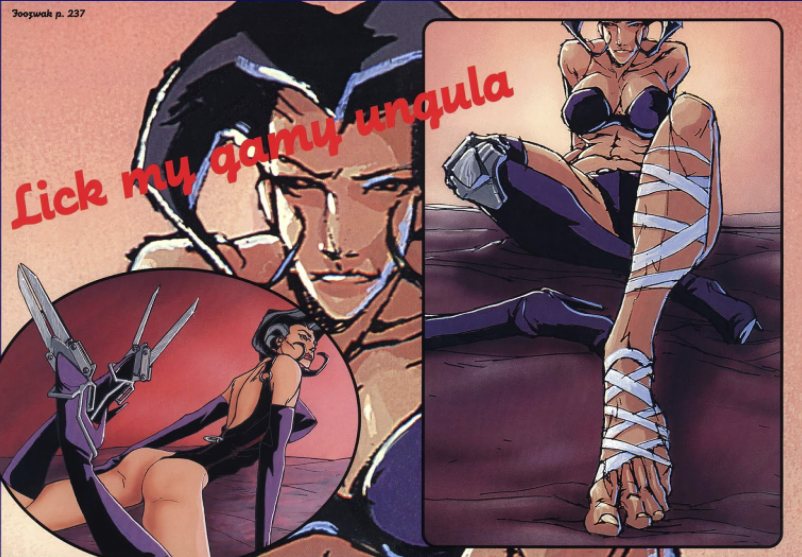
The conflict between Bregna and Monica is ultimately just a proxy war for Aeon and Trevor’s deeper, weirder struggle. They have the one of the most unique relationships I’ve ever seen in fiction. They pretend to want to kill each other but clearly don’t. They both ignore countless opportunities to pull the trigger. They care very deeply about each other in a way irreduceable to mere love or hate.
Basically, Trevor Goodchild is a benign Orwellian dictator. He’s not a villain, but he’s often misguided. He wants to progress humanity, and views morality as a constraining process. Or as he puts it: “one doesn’t want to be trapped into making a particular choice simply because it’s right.”
Trevor lives in the hell of every totalitarian dictator; he can’t tell the truth to the people, and his underlings deceive and backstab him in turn. The gulf between what he wants and what he gets is incommensurable. He seeks to build a rational, open society, without secrets, yet he exists in nest of snakes, unable to trust or connect with anyone.
Aeon Flux exists in a hell of her own. She’s free…which means she’s a slave to chance and consequence. She has the liberty of a moth in a flame. Her actions almost always have nasty, unforeseen consequences (both for herself and the people she cares about) and unlike Trevor she can’t even hide behind noble intentions. The reverse of hell is not heaven.
The Herodotus File was written by Mark Mars and Eric Singer. Mars is a colorful guy Peter Chung met at CalArts. He has done virtually nothing aside from Aeon Flux, but he created many of the show’s most electric moments (“ready for the action now, danger boy…?”) Eric Singer was a lowly production assistant who cold-called Chung one day. He is possibly the most financially and critically successful person ever associated with the show (he was nominated for an Oscar Award for American Hustle, and co-wrote an upcoming Tom Cruise vehcle).
The danger of a book like this is that it will talk the show to death. Aeon Flux discusses universal problems of censorship, surveillance, etc. This goes away when you specifically place it (as the movie did) in a particular point in time, such as the far future. Specifics are the enemy.
The book threads this needle by being completely ludicrous, far more comical than the show, and impossible to take seriously. But there’s a lot of wit and fun along the way. The book makes me wish the show had contained a little more of Mars and Singer’s humor to lighten the dourness.
Aeon Flux fans probably can’t trust one word of The Herodotus File. Peter Chung (who had little involvement) says it should be viewed as a work of propaganda or disinformation. Unreliable. It’s a window into the Aeon Flux world, but not an accurate one. Take it as seriously as brings you pleasure.
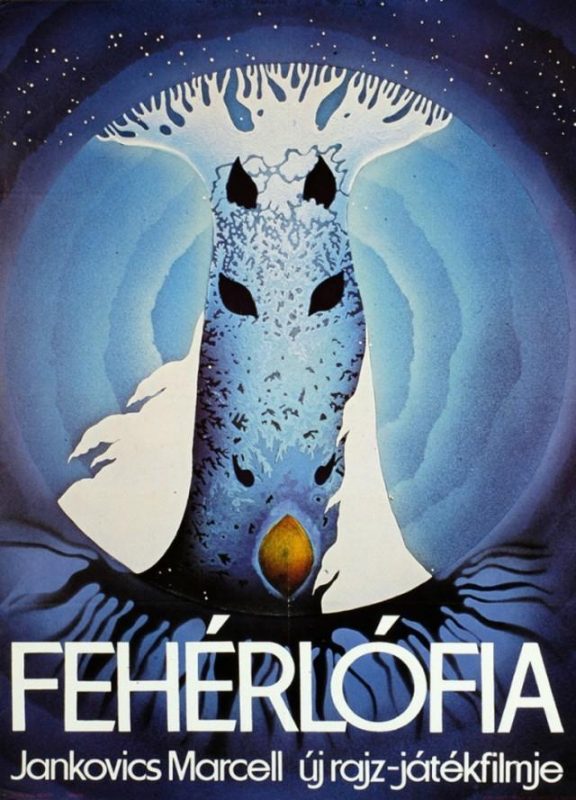
Some art forms are like staring across a large and flat field. Sunday morning comics (do they still exist?) are all the exact same quality. There are no good ones or bad ones. Garfield could be the best of its kind or the worst. There’s no way to tell. Their bell curve is a bell line: a single vertical stroke that is both infinitesimally thin and high enough to leap into the stratosphere.
2D animation is different: its a plain ridged by great peaks and crevassed by huge gulfs. When it’s bad it’s incredibly bad: the worst thing ever conceived of by the human mind is probably animated. But for me, great animation exists on a level that basically nothing that’s not an animation can touch.
Son of the White Mare, or Fehérlófia, is a 1981 Hungarian animated film that I watched on Peter Chung’s recommendation. I was curious as to what I’d get out of it, considering I know only one Hungarian word, “Tökfej” (lit. “squash-head” but with idiomatic sense between “idiot” and “asshole”), and only because a heavy metal band recorded a song with that title.
It’s like a Disney film, in that it adapts a folk story (in this case, an “ancient Hunnic and Avaric legend” of the three brothers, Fanyüvő, Kőmorzsoló, Vasgyúró, who fought a war against an army of dragons). But where Disney films are reverent as a dull church service, Fehérlófia is energetic and lively. And where Disney films try for styleless realism, Fehérlófia wants to be like nothing you’ve ever seen before.

A realistic myth is a contradiction in terms, and it wastes no time in trying to be “faithful”. Instead, it’s a surrealist vapor that seems made to be inhaled rather than watched. This is one of those midnight movies viewed by college kids who snicker “what drugs were they on?” Probably none. Something can invoke a psychedelic state without being authored in a psychedelic state – it’s probably easier if it isn’t. LSD is formulated by trained chemists, and pressed into pills by machines.
Imagery grows on Fehérlófia’s cel plates like mushrooms on a fallen log. Colors mean things, shapes mean things. It’s a masterclass on how to talk with paint instead of words. I found the voice-acting to be annoying and anti-climactic, and if not for the music (which was nice) I probably would have viewed the film on mute.
There’s a lot of “shape language”, and things get pretty symbolic, with the heroes having rounded, organic shapes and the monsters having an industrial, Soviet brutalist aesthetic. I don’t think Fanyüvő ever calls a dragon a tökfej, but he should have: they’re real pieces of work.
There’s also a psychosexual undercurrent you wouldn’t get from Disney – somehow, Fanyüvő’s sword always ends up hanging between his legs.
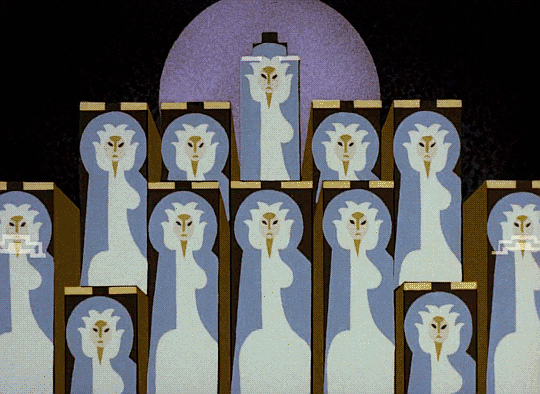
It’s technically creative, too. Fehérlófia does not have a single line. Color is allowed to clash directly upon color, without dark penstrokes getting in the way. This gives it a fluidic feel, like watching a lava lamp bubble. And though it might seem the opposite of the “ligne claire“ style of Tintin, it achieves the same effect: combining everything on the frame into the one level. Most animation has a clear distinction between foreground action and background plate. Here, it’s basically all action.
(I’m interested in how exactly the key animator worked. Were lines drawn as a reference and then discarded? Were cels painted freehand?)
It’s a testament to visual storytelling that my illiteracy didn’t seem to matter, because I was fascinated by Fanyüvő’s quest, and the way it was depicted in abstract incinerations of light and color.
The film was created by Marcell Jankovics worked under the auspices of Pannonia Film Studio, one of Hungary’s few native animation studios (One of Pannonia’s alumni includes Gábor Csupó, who co-founded the animation studio known for Rugrats et cetera). He made several films, which have a certain niche appeal. His most famous mainstream moment was probably the film that ended up becoming The Emperor’s New Groove. What’s the the Hungarian version of “Alan Smithee”?
According to IMDB, production was difficult.
According to the director, the animation crew had to work under horrible conditions. Their work building was a rickety wooden construction added to the main studio building. Concept art and other production papers were carelessly littered across the floor and trampled over, as the studio saw no point in preserving them. The celluloid sheets were scratchy and of low quality, and the paint had a tendency to form clumps and crumble off the cels after drying. At one point, 600 completed animation cels had to be thrown out and hastily redone because they were unusable. The animators eventually decided to start manufacturing their own paint, and Jankovics himself helped out with painting the cels. He recalls that the work was so stressful, one of the artists broke out in tears. To buy more production equipment that Pannonia Studio couldn’t afford, the people working on the film even had to take up additional jobs elsewhere.
Movies like this don’t make money. Animation in general was in a slump in the 80s – even Disney was in a precarious situation – and animation for adults has always been a rough sell. The fact that Fehérlófia was made against adverse winds adds to its scrappy charm.
Some things entertain, illuminate, inspire. But some do something more: make a case that their medium is worthy of existence. Fehérlófia is one of the heights of animation. It’s a brilliant, elegant lawyer’s brief for the entire animation genre, showing what’s great about it, and why it’s important.
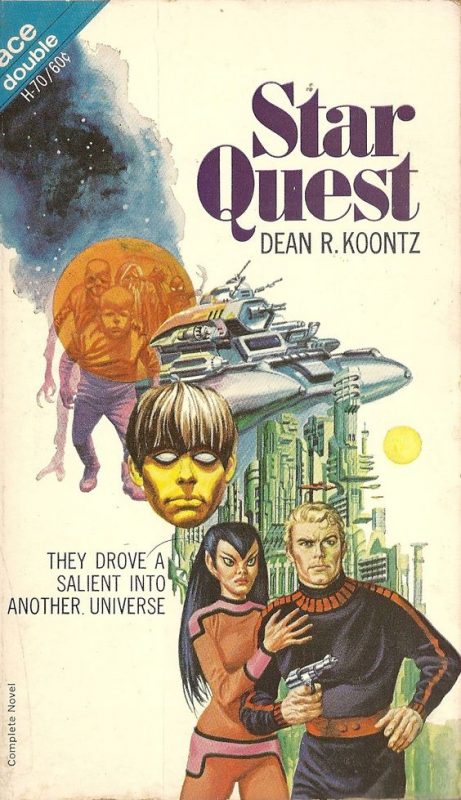
The Dean Koontz of 2022 has hair plugs and writes preachy stories about libertarian gun owners who fight supernatural strawmen for collectivism and/or postmodernism with the aid of guardian angels and/or pet dogs. The Dean Koontz of 1968 had no hair plugs and wrote Heinlein-style science-fiction.
Star Quest is his first book, if it can even be called that. It’s a 25,000 word novelette that was packaged as part of an “Ace Double”, along with Doom of the Green Planet by Emil Petaja. Ace Books told Dean that his side of the split was too short, and asked if he would accept $1250 so Petaja could get $1750. Years later, Petaja revealed that Ace Books had run the same line on him – he would get $1250 and Koontz $1750!
The story’s a military SF yarn. A sentient tank called Jumbo Ten (lol) is fighting a war for the despotic Romaghins against the invading Setessins when he suddenly he realises that he’s not a machine at all, and that his brain is from a human called Tohm (gross). This realization causes him to go AWOL mid-battle and begin searching for his missing past. Interesting, there’s a piece of Stephen King juvenilia (“I’ve Got to Get Away!”) with nearly the same basic plot.
To state the obvious, Star Quest was written quickly by a young man. It has problems typical of books written quickly by young men.
Laser cannon erupted like acid-stomached giants, belching forth corrosive froth that even the alloy hulls could not withstand for any appreciable length of time.
Why are the “laser cannon” belching “corrosive acid”? Many books fuck up their continuity, but usually not in the same sentence.
Koontz loves flowery literary passages, so our novel about a sentient tank called Jumbo Ten also has stuff like this:
But the Fates, those fickle ladies, will often change their minds and lend a hand to those they have so callously crushed before. His web of life had been spun by Clotho who immediately washed her hands of it and moved on to another loom. Lachesis, who measured the length of his strand, decided to fray it down slowly to whittle it to near nothingness. But now, just as Atropos was coming forth with her golden shears to snip it completely, Clotho had a change of heart. Perhaps, she was unemployed and restless that day, looking for something, anything to do. In any event, she stopped Atropos with a kind word and a cold stare, and began spinning again more thread…
Was “those fickle ladies” really the right phrase? Myself, I would have gone with “those goddamn broads.”
Ace Books did not use their stolen $500 to pay for copyediting, and the book contains even more spelling errors than this review. Jumbo Ten, we learn, is made of “alloyed steal”. I will allow that “He opened his corn-system” is probably an OCR error in the digital copy I found.
The story is fast paced and somewhat exciting. And it does have ideas, like a sci-fi invocation of the “multiverse” theory well before Heinlein wrote The Number of the Beast.
But Tohm/Jumbo Ten’s motivations are too stock to be interesting: he wants to go home, find his girlfriend, etc. These universal impulses are supposed to make him sympathetic, but they’re too universal: he loses his identity in a sea of other sci fi heroes who are characterised in exactly the same way. He might be convinced he’s a living person, but he does not convince the reader.
In 1968, it would have been the literary version of fast food: made cheaply and consumed quickly. But now, it’s something more: an interesting curio from a very famous writer’s past. Authors only get one first novel, and it’s fascinating that this was Koontz’s. Themes of individualism are the only thing bridging his work from then to now. Otherwise, this is a totally different writer, and a reminder that (despite arguments otherwise), we fundamentally aren’t the person we were yesterday, and also not the person we will be tomorrow.






